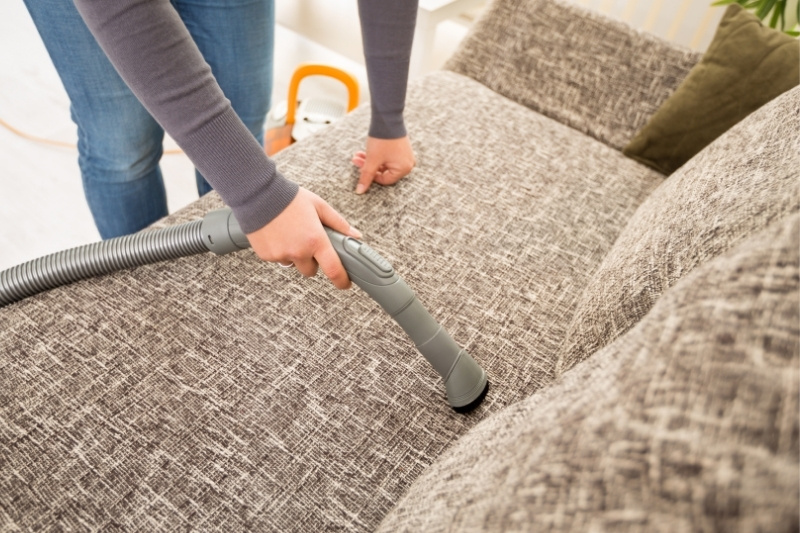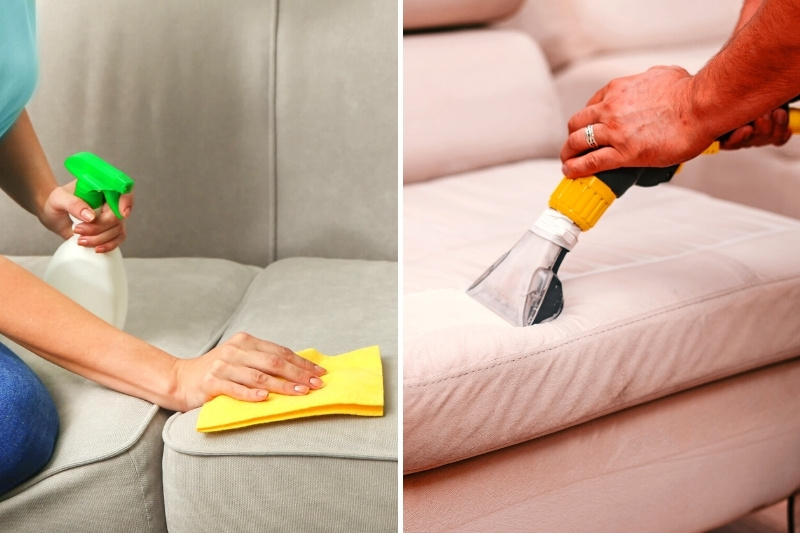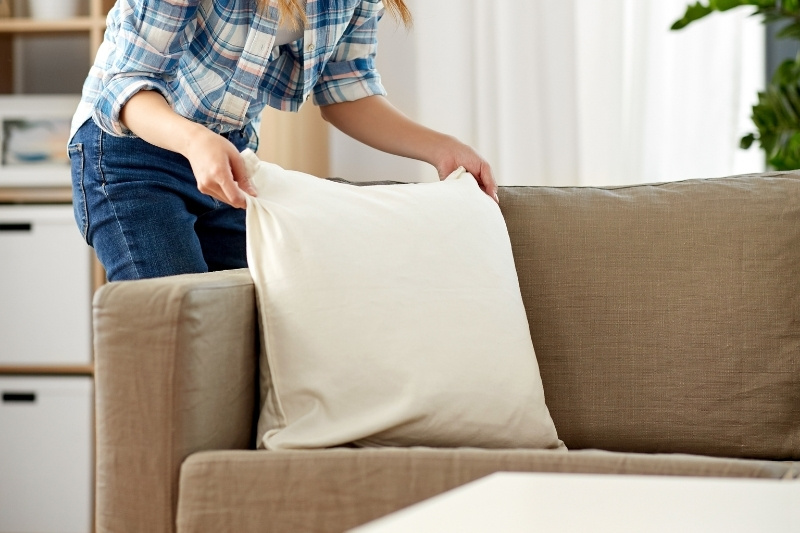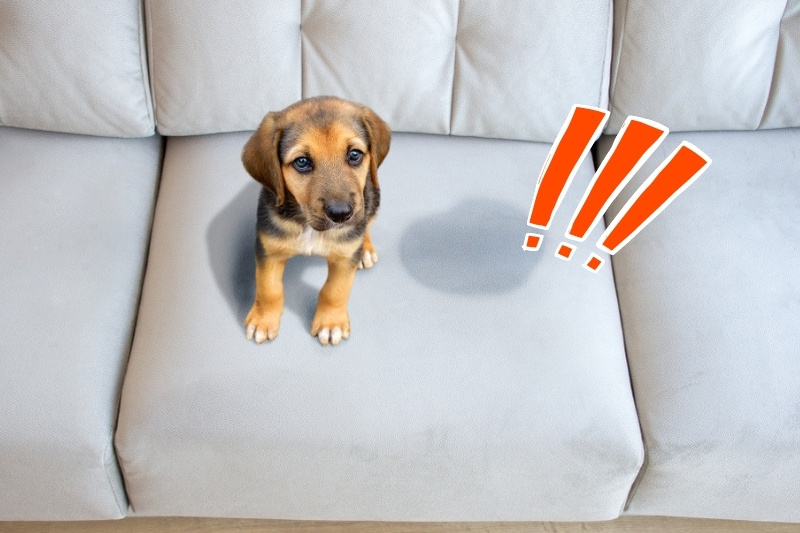A smelly sofa isn’t exactly appealing, and it’s definitely not what you want to chill out on after a hectic day at work.
When it comes to removing odours from a couch, the process is fairly straightforward. But you’ve got to make sure that you choose the right method for the material you’re working with. You’ll treat a fabric sofa differently to a leather one, for example.
How to Get Smells Out of a Sofa
Step 1: Examine your sofa

A helpful place to start is simply have a look over your settee. A quick check may be able to tell you what/where the bad smell is coming from.
Has someone spilt a drink, is a cushion a bit stinky, or has someone tucked an old banana down the side of the seat?
If you can spot where the smell is coming from early on, you might be able to deal with the issue by performing a spot treatment and removing stains, washing a cushion or just by hoovering up the offending mess. If this is the case, you may be able to solve your stinky problem very quickly.
Of course, it doesn’t always work out so easily because you may not be able to find a stinky culprit.
In this case you may just have a smelly couch because of general wear and tear, and you’ll need to deodorise the entire piece.
Step 2: Remove cushions and blankets
Before you start to refresh your sofa it’s worth removing all the cushions and blankets, so you can treat it properly.
If you leave items on your settee, you won’t be able to reach all the nooks and crannies. Given that this is probably where the stench is lurking, you really need to be able to reach these spots.
It’s worth washing your cushions and blankets at this point – just to make sure all the bad smells and grime are gone.
Step 3: Vacuum

Hoovering your settee will remove any offending crumbs, hair and general dirt from it. Remember to clean between the seat, down the side of the arms and towards the back of the sofa. You’ll be amazed at how much money alone you’ll find down there!
Step 4: Choose your deodoriser
What deodorising product you use will depend on what your couch is made out of. So, go with the option(s) that applies to your particular upholstery.
You should also check the tag on your sofa to get information on how to care for the material. Some manufacturers will give you exact cleaning instructions.
Tip: Always do a patch test with your chosen deodorising method.
Fabric sofas

Below you’ll find a few different ideas you can try:
- White vinegar, rubbing alcohol and water – In a sprayable bottle mix 120 ml of white vinegar, 120 ml of rubbing alcohol and 240 ml of warm water. You can also add an essential oil of your choice—a few drops will do.
Mix the ingredients in the bottle and when you’re ready start spraying your sofa. Try to stand a few feet away from the settee when you spray, so you don’t oversaturate a particular spot. Grab a clean cotton cloth/paper towel to mop up excess liquid. - Bicarbonate of soda (baking soda) – After removing all the cushions, covers and pillows from your sofa, you can cover your entire sofa in bicarbonate of soda.
- You’ll need to sprinkle the bicarb generously to ensure it makes its way into all the crevices, so it can draw out the bad smell(s). You’ll need to leave the bicarbonate of soda to rest on the sofa for at least an hour, but overnight would be better. Then you need to hoover the bicarb up.
- Activated charcoal – Activated charcoal in packs can absorb poor odours from your sofa. Simply pop a few bags under/near the sofa. Depending on the size of your sofa, you may need to use more packs.
- Bicarbonate of soda and essential oils – If you mix three cups of bicarbonate of soda, with some essential oil and warm water in a spray bottle you can create your own deodoriser.
You can spray this deodoriser over your sofa from a distance to neutralise smells. You can also swap out the bicarbonate of soda for white vinegar and it’ll have a similar effect. - Fresh air and sunlight – In some cases, all you need is a touch of fresh air and sunlight to eradicate a poor smell(s).
If your sofa has been stuck in a storage container or a poorly ventilated room, the easiest solution would be to expose the settee to clean air and light. - Steam cleaning – In some cases you can steam clean a fabric sofa, but you do need to check with your sofa’s manufacturer before doing this. Steam that comes out of a steam cleaner is very warm and can damage some materials.
Leather sofas

Below you’ll find a few different ideas you can try:
- White vinegar and water – In a spray bottle mix 120 ml of white vinegar with warm water. And spray your leather sofa from a distance with this deodoriser. If you need to mop up any spills, use a clean soft cloth.
- White vinegar and olive oil – In a spray bottle mix 60 ml of white vinegar with 120 ml olive oil. Shake the bottle and squirt this mixture over the sofa to draw out and neutralise the poor odour(s).
Specialised deodorising products

You can also pick up branded deodorisers to freshen up your sofa. Here are some examples you can look into:
- Astonish C1926 Fabric Refresher Trigger Spray boasts long lasting freshness that isn’t overpowering, is simple to use, and can work wonders on smoky upholstered sofas.
- Febreze Fabric Refresher Anti-Bacterial also comes in a spray bottle, can clean away stinky odours and replace them with a fragrant citrusy scent. In addition to this, the spray can also get rid of germs. So not only will your sofa smell clean but it will also be free from nasty bacteria.
Tip: Always do a patch test. And make sure the product is suitable for your sofa.
Step 5: Deodorise
Once you’ve picked your deodoriser you can proceed with using it.
When trying to get rid of smells from a couch it’s better to keep your windows and doors open, and keep pets and kids away from the treatment area.
After treating the couch, you may need to allow it to dry. So, make sure nobody sits on it during this time.
Note: As with most treatments, you might find that you have to repeat your chosen deodorising method multiple times to see significant results. And in some cases, you may have to swap your deodorising method for another.
Step 6: Adding the final touches

Once your sofa is dry and the bad smell(s) is gone, you can return any cushions and blankets to your sofa. These items should’ve been cleaned themselves, or were at least aired, during the deodorising process, so they shouldn’t be harbouring any unpleasant odours or dirt.
If you find your couch still has an unpleasant odour, it might be time to hire a professional cleaning service.
How to Protect Your Sofa from Foul Smells

Here are a few tips on how you could look after your sofa, so it doesn’t get mucky and plagued with odours:
- Clean up dirt before it festers and gets pongy.
- Regularly clean your sofa, so you remove as much grime and stench as possible. A simple weekly hoover would do the world of good.
- Tell people to take their shoes off before putting their feet on the sofa, so they don’t traipse whiffy muck over the fabric.
- Wipe your furry pal’s paws before they jump up onto the settee.
- Use a tray when you eat food on the sofa, so it can catch the drips. Sometimes small food splatters go unnoticed to the naked eye, but they can turn into an assault on the nostrils in no time.
- Cover your sofa. The protector in question should stop large amounts of dirt and odour from getting to your sofa. You should also pick a protector that can be laundered, so you can keep on top of the cleanliness and freshness.
- Put blankets over your sofa when you know there’s a chance that it could get dirty and start to smell.
What Causes Sofas to Smell?

There are loads of reasons why your sofa could be smelling. Here are some ideas to think about:
- Spilt drinks (red wine, juice and lemonade, for example).
- Spilt food (milk, sauce or gravy, for example).
- Someone had an accident (urine or feces). It’s worth cleaning urine and fecal messes with an enzyme cleaner, particularly if your furry friend had an accident. Your pet should be discouraged from re-peeing on the spot if you do so.
- Sweat can make sofas a bit smelly.
- Outdoor dirt like rain and mud can be smudged into and over a sofa. In turn, they can start to stink of dampness and earth.
- Wet toys that have been stuffed down the side of a sofa can create quite a stench.
- General wear and tear.
Any one or multiple ideas from the list above could be making your sofa smell funky. And ideally, you need to get to the root of the problem and clean it away before it starts to cause a really whiffy drama.

Bethan has a passion for exploring, reading, cooking and gardening! When she’s not creating culinary delights for her family, she’s concocting potions to keep her house clean!






